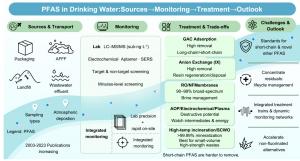From forever chemicals to PFAS-free drinking water: Mapping a 20-year global research landscape and governance roadmap
GA, UNITED STATES, October 29, 2025 /EINPresswire.com/ -- An international research team reveals consistent growth in PFAS research by conducting bibliometric analysis of 1,281 publications from 2003 to 2023. The study, conducted using analytical tools like CiteSpace and VOSviewer, identifies the United States, China, and Sweden as the leading contributors. It provides a comprehensive overview of PFASs in drinking water, highlighting that their entry into water supplies is governed by surface runoff, soil leaching, and atmospheric deposition. While traditional analysis relies on liquid chromatography–tandem mass spectrometry, new portable sensors are emerging. Current removal strategies—such as activated carbon, ion-exchange, membranes, and advanced oxidation processes—involve significant cost-performance trade-offs. Key persistent challenges include monitoring short-chain and novel ether PFASs, managing concentrated waste, and establishing unified regulatory standards. This study aims to guide future research and policy to accelerate the achievement of PFAS-free drinking water.
Per- and polyfluoroalkyl substances (PFASs), often called “forever chemicals”, are highly persistent and widely distributed contaminants that pose a serious threat to drinking water quality. In a study published in Water & Ecology, an international team used bibliometric analysis of 1,281 Web of Science–indexed publications (2003–2023) to document sustained growth in research on PFASs in drinking water. For the first time, the study integrates pollution pathways, monitoring, and treatment into a single framework that directs researchers and regulators to the key bottlenecks—namely, the challenges of monitoring and removing short-chain and ether-based compounds and safely managing concentrated treatment residuals.
The results reveal that research on the fate of PFASs in drinking water has evolved through three distinct phases:
1. Initial Phase (2003–2008): Modest activity with an average of four publications per year, establishing a theoretical foundation.
2. Gradual Development (2009–2016): Steady growth averaging 31 publications annually, although health correlations remained unclear.
3. Rapid Growth (2017–2023): A dramatic surge accounting for 79.12% of all publications, averaging 148.86 papers per year—largely triggered by regulatory actions such as the 2017 US EPA health advisories.
Logistic models project continued growth, with cumulative publications and citation frequencies expected to reach 7,689 and 241,696 by 2030, respectively. The majority of relevant research falls within the domain of Environmental Sciences and Engineering with the United States, China, and Sweden being the leading contributing countries.
The study also provides an overview of PFASs’ sources, transport, analytical detection, and mitigation in drinking water. Major pathways for PFASs’ entry into water sources include surface runoff, soil leaching, and atmospheric deposition. While traditional analysis relies on liquid chromatography–tandem mass spectrometry, new portable high-selectivity sensors are emerging. Current removal strategies such as activated carbon, ion-exchange, membranes, and advanced oxidation processes, involve notable cost-performance trade-offs.
“Research on per- and polyfluoroalkyl substances in drinking water must shift from fragmented exploration to coordinated, system-level action—anchoring analytics in laboratory liquid chromatography–tandem mass spectrometry and linking them with field-deployable, high-selectivity sensor networks and standardized data to close monitoring and risk-identification gaps for short-chain and ether-based compounds,” says first author Chong Liu. “In parallel, we shouldadvance multistage ‘intercept-and-destroy’ treatment trains and the safe management of concentrated residuals, using cost–performance benchmarks and tiered standards to accelerate adoption and translate scientific progress into safer drinking water.”
References
DOI
10.1016/j.wateco.2025.100017
Original Source URL
https://doi.org/10.1016/j.wateco.2025.100017
Funding Information
This research was supported by the Science and Technology of Alaer City Project (2025GX06), the President's Foundation of Tarim University (TDZKCX202404), and the Bingtuan Science and Technology Program (2021DB019; 2022CB001-01).
Lucy Wang
BioDesign Research
email us here
Legal Disclaimer:
EIN Presswire provides this news content "as is" without warranty of any kind. We do not accept any responsibility or liability for the accuracy, content, images, videos, licenses, completeness, legality, or reliability of the information contained in this article. If you have any complaints or copyright issues related to this article, kindly contact the author above.

